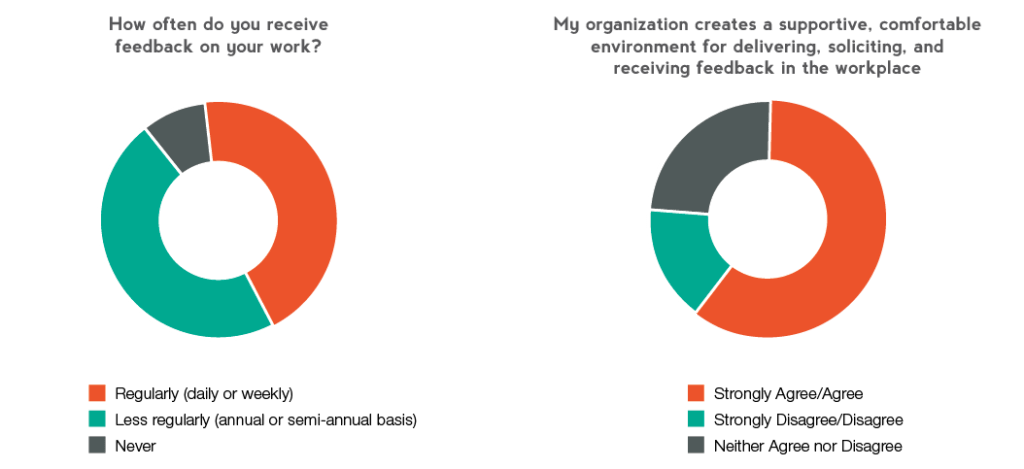Report
Feedback on feedback: Five ways to create a constructive feedback culture

A recent Eagle Hill nationwide survey of over 1,700 professionals across a range of industries and career levels highlight the significance of workplace feedback and informs five simple actions to promote a healthy feedback culture at your organization that can yield and sustain major benefits.
A company’s people are its most valuable asset and, for most organizations, its biggest investment. While investment varies across industries, workforce costs can be more than half of operating expenses. Even so, a clear, demonstrated commitment to the development of people and a healthy work environment is easily lost in the shuffle of day-to-day business operations. While Human Resource departments regularly assess and work to improve performance management tools, such as appraisals, performance reviews, rewards, and recognition programs, there is little feedback on feedback itself.
Consider the following questions:
- What is the value of feedback to an organization and its
work culture? - Do employees value feedback and are they receiving it?
- What is the best way to deliver feedback and how do you
prepare employees to give and receive this information?
Understanding how feedback can affect the performance of an organization and its people can help leaders foster a more
positive, productive workforce that is better prepared and capable of advancing the organization’s goals.
EAGLE HILL NATIONAL WORKPLACE FEEDBACK SURVEY
Eagle Hill conducted a nationwide survey polling employed respondents about their experiences receiving feedback.
When
March 2015
Where
United States
Who
Sample of 1,700 professionals across multiple industries and generations
What is feedback?
Feedback is about information sharing. Though perhaps most commonly thought of as top-down information sharing from supervisors to their staff, and often further stereotyped as the sharing of negative information, feedback is actually about co-workers at all levels reinforcing each other’s good work and offering constructive advice on areas for future improvement. Though the common images of difficult conversations and structured performance reviews are important components of feedback, they should only be a small portion of the larger, constructive feedback that happens on a daily or weekly basis that makes your employees feel valued by and engaged with the organization. When used correctly, feedback can be a powerful tool to increase confidence, build competencies, and encourage performance excellence. It offers channels for praise and creates learning moments for supervisors and staff alike that help an organization make the most of its people’s performance strengths and encourage continuous improvement.
Why focusing on feedback matters
The overwhelming majority of employees surveyed in this research see feedback as a positive contributor to their current role as a member of an organization and to their ongoing professional development. In fact, about 85 percent of 1,700 respondents reported that they feel valued when offered feedback and that they believe it is important to their professional development (Figure 1). However, despite the positive perceptions employees hold towards the potential value of feedback, only 44 percent of respondents said that they receive feedback on their work on a regular basis (Figure 2).
FIGURE 1: EMPLOYEE PERCEPTIONS OF THE VALUE OF FEEDBACK TO THEIR WORK-LIFE

FIGURE 2: THE ACTUAL PRACTICE OF GIVING AND FOSTERING FEEDBACK

Furthermore, only 60 percent of respondents agreed or strongly agreed that their work environment fostered an environment that supported constructive feedback. Given the gap between employee’s perceptions of the potential value of feedback and the actual practice of offering feedback and fostering a healthy work culture for feedback, this paper will offer five practical steps organizations can take to close the divide and yield the benefits of a happier, more productive workforce.
Create a feedback-focused culture
Maximizing your organization’s investment in its people and creating an enterprise-wide environment in which giving, receiving, and soliciting feedback is comfortable across levels takes a commitment to change over time. However, employees, supervisors, and executive leaders can collectively take small steps to create a culture of shared feedback:

FREQUENCY
1. Provide feedback on a frequent basis.Do not wait until your annual or semi-annual performance appraisal cycle to provide constructive advice and positive reinforcements to your staff and colleagues. Fifty-five percent of survey respondents reported that they would like feedback on their work on a daily or weekly basis. This was especially true for younger employees, as 72 percent of respondents under the age of 30 responded that they would like this more regular feedback.
Your employees want constructive input on their work and they want it frequently. Taking steps to provide regular feedback immediately increased communication among employees, teams, and different staff levels. These more-open communication channels can help foster an inclusive, supportive environment in which your employees feel valued for their contributions and are able to build upon their strengths and improve upon any areas of weakness.

DELIVERY
2. Deliver feedback in person.
Emailing feedback or discussing it over the phone may be your only option in a time-crunch or with a geographically dispersed staff, but these approaches should not be your go-to methods of communication.
The majority of employees surveyed (78%) expressed that they prefer to receive feedback in person, as opposed to over email or the phone. While it may be easier to summarize thoughts in an email or hide behind a telephone, more personal conversations will be best received by employees. Your organization can capitalize on this opportunity by encouraging employees to have regular, in-person feedback discussions with peers and supervisors.

RECOGNITION
3. Recognize when your employees do good work and when they make changes as a result of constructive feedback.
It takes practice and a positive work environment to develop a work culture in which employees and supervisors are comfortable soliciting, receiving, and offering feedback. Two key ways to support feedback are to offer employees positive reinforcement for good work and to recognize when employees make improvements as a result of prior feedback. In fact, of our survey respondents who indicated that their company had a “comfortable feedback environment”, 83 percent said they are positively recognized when they make changes in line with advice they received. Therefore, when employees do great work, be sure to verbalize your satisfaction so they know to continue the behavior and when they improve a work product or behavior after receiving feedback, let them know that you see and value the changes they made.

360-DEGREE FEEDBACK
4. Encourage feedback beyond supervisors.
Though most feedback flows from supervisors to their staff, there are other, potentially less obvious, channels through which to encourage feedback that may benefit your employees and the overall work culture at your organization. While employees reported that supervisor feedback was still the most valuable to their work and professional development, about 45 percent of respondents said that they valued feedback from their peers and clients or customers. However, despite the potential value of this non-supervisory feedback to your employees, less than 30 percent of respondents said that they receive feedback from these groups in their job. Companies can address this gap by fostering a supportive, comfortable workplace with formal and informal channels through which employees can receive feedback from their peers or clients.
Ask staff members to share work products with their colleagues for input and urge employees to actively and frequently solicit input from both peers and clients. Moreover, take steps to be sure employees have the space to offer feedback to their supervisors to not only improve the performance of your organizations’ managers and leadership, but also to set a precedent for feedback being a positive aspect or your culture from which everyone can benefit.

TRAINING
5. Offer feedback training for both supervisors and employees.
As your staff starts to engage in feedback conversations on a regular basis, it is important to provide support by conducting trainings for both supervisors and employees.
Company-wide trainings help establish expectations, promote and reinforce best practices, share helpful resources, and rally your workforce to take steps to change together. Despite the value of training in preparing staff for cultural and systematic changes, only about 25 percent of our survey respondents said that their organization provides feedback training to supervisors and employees. Employees understanding how to give and receive feedback in a healthy, constructive way is not as intuitive or well-understood as it may at first seem. Therefore, trainings can help manage expectations and can offer valuable skills about how to constructively engage in feedback conversations as your staff learns new ways of sharing information, whether it be positive or negative, with one another. Start small with an introductory training session to begin the company dialogue about feedback.
Because people matter
People are the lifeblood of government agencies, companies, and nonprofit organizations. Great leaders recognize that employees need regular, substantive feedback to develop their skills, optimize performance, and achieve both individual and organizational goals. Our workforce survey confirms that employees place just as much value on receiving feedback.
To foster a supportive company culture in which all employees are recognized for their good work and are offered advice for how to develop professionally, organizational leadership must understand the benefits of feedback; communicate those benefits to both employees and supervisors; and create an environment that supports continuous staff engagement in giving, soliciting, and receiving feedback.

